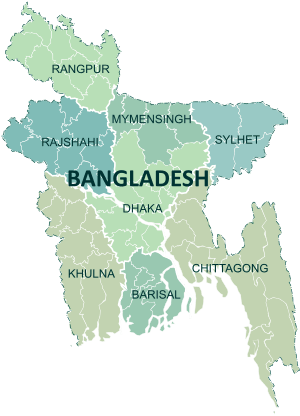Jamalpur District
Jamalpur (Bengali: জামালপুর জেলা, Jamalpur Jela also Jamalpur Zila) is a district in Bangladesh[1] part of Mymensingh Division. It was established in 1978.[1] It occupies 2031.98 km².[1] It is located in between 24°34' and 25°26' north latitudes and in between 89°40' and 90°12' east
| Jamalpur জামালপুর | |
|---|---|
| District | |
 Location of Jamalpur in Bangladesh | |
| Coordinates: BD 24°55′N 89°58′E / 24.92°N 89.96°ECoordinates: BD 24°55′N 89°58′E / 24.92°N 89.96°E | |
| Country |
|
| Division | Mymensingh Division |
| Area | |
| • Total | 2,031.98 km2 (784.55 sq mi) |
| Population (2011 census) | |
| • Total | 2,292,674 |
| • Density | 1,100/km2 (2,900/sq mi) |
| Time zone | BST (UTC+6) |
| Postal code | 2000 |
longitudes. It is bounded by Meghalaya state of India, Kurigram and Sherpur districts on the north, Tangail district on the south, Mymensingh and Sherpur districts on the east, Jamunariver, Bogra, Sirajganj and Gaibandha districts on the west. The main town is situated on the bank of the river Brahmaputra, 140 km (87 mi) north of Dhaka, the national capital.
Population
Total 2107209; male 1075694, female 1031515; Muslim 2067685, Hindu 37449, Buddhist 848, Christian 66 and others 1161. Indigenous communities such as Garo, Bangshi, Hajong, Hodi, Kurmi and Mal belong to this district.
Water Bodies
Main rivers:Jamuna,Old Brahmaputra, Banar, Jhinai; Kharka Beel, Kaiyer Beel, Chiradhuni Beel, Chilmari Beel, Kaludaga Lake, Ranipukur Dighi and Harishchander Dighi are notable.
Historical Events
Most notable historical events of the district includeFakir-sannyasi resistance(1772-1790),Indigo resistance movement(1829), Famine (1874), Construction of the railway communication (1899) and the War of Liberationin 1971. The Pak army, in collaboration with the local razakars, conducted heavy genocides in Jamalpur. On 21 June, the Pak army killed 9 persons at the Shashan Ghat (cremation centre) of Jamalpur sadar upazila on the bank of the Brahmaputra. A battle was fought between the freedom fighters and the Pak army on 31 July at Kamalpur Pak Army Base of Bakshiganj upazila causing heavy loss to the occupation army; in this battle 35 freedom fighters including Capt. Salahuddin Momtaz, Ahaduzzaman, Abul Kalam Azad were killed. A battle was fought between the freedom fighters under Sector Commander Col.abu taherand the Pak army on 13 November at Kamalpur of Bakshiganj upazila. In this battle Col Taher was seriously wounded. The well protected Pak military base at Kamalpur eventually fell on 4 December in the face of heavy attack by the freedom fighters for 21 days. In this battle 220 Pak soldiers under Capt. Ahsan Malik surrendered to the freedom fighters.
Marks of the War of LiberationMass grave 33; mass killing site 1; memorial monument 4.
Tourists Spots
Revenue office and Dighi of the Zamindar at Fulkocha and Mahiramkul (Melandaha Upazila), Neelkuthi at village Tartapara (nearly reined, in Madarganj Upazila), Narapara Fort (Sharishabari Upazila), Radhanath Jeu Mandir, Sholakuri Hill at Nandina, Ranipukur Dighi at Sreepur, Harish Chandra Dighi at Chandra (Jamalpur Sadar Upazila), Kuthibari of Pradyut Thakur (Islampur Upazila),garo hills(Bakshiganj Upazila). [Samar Pal]
Economy
Jamalpur is an important market center for the rice, sugarcane, jute, tobacco, and mustard produced in the region. The city is connected by road, rail, and river with Dhaka and the rest of the country. It has a railway station and three dakbungalows.
The town's main exports are jute, tobacco, mustard seed, peanut, leather, egg, pulse, betel leaf and handicrafts.
Making nakshi kantha (embroidered quilts) is a traditional occupation.
Demography
The town has a population of 116754; male 51.06%, female 48.94% at a density of 2191 per km².
Subdistricts
The town is divided into seven upazilas & one police I.C
Folkculture
Various kinds of folk songs are prevalent in the district. These include Gunaibibir Gan, Jari Gan of Khairun, Palagan of Rupvan, Panchali, Ghetu Gan and Meyeli geet (songs sung by women on the occasion of marriage and Gaye Holud festivals). In the rural areas, various folk games and sports are performed on competitive basis. These include bull fight, horse race, Moi (ladder) race, Lathi Khela (stick game); besides, during the rainy season boat races are arranged in the Jamuna river. The Garo community of the district perform dances on the 'Bigan Gala' festival.
See also
References
| Wikimedia Commons has media related to Jamalpur District. |
- 1 2 3 Samar Pal (2012). "Jamalpur District". In Sirajul Islam and Ahmed A. Jamal. Banglapedia: National Encyclopedia of Bangladesh (Second ed.). Asiatic Society of Bangladesh.
